MONDAY, JULY 14, 2025
UO services offer safe ways for students to get home



MONDAY, JULY 14, 2025
UO services offer safe ways for students to get home


UOPD revives bike valet program as campus thefts continue to rise.
By Sydney Seymour and Ana Narayan Investigative Reporters
Despite recent efforts to decrease them, bike thefts on and near the University of Oregon campus increased by approximately 24% in one year, rising from 96 reported incidents in 2023 to 119 reported incidents in 2024, according to the University of Oregon Police Department’s Clery Act crime logs.
Bike thefts peaked in 2024 during the summer and fall months, with 11 in August 2024 and 16 in October 2024. More recently, in April 2025, there were 16 reported bike thefts. In April of 2024, there were only six. As summer approaches bike thefts are in peak season.
“Now that the weather’s getting better, now is that prime time,” UOPD Police Chief Jason Wade said, referencing the bolstering efforts to prevent bike thefts.
“Keep My Seat Warm,” a bike valet program for extended school break, is back again this summer under a new name: “No Bike Left Behind.” Launched in 2020, the program offers a free valet service for students and their bikes, holding them in a UOPD secure location until students are available to retrieve them.
All bikes held in storage must be picked up by October 10 and will be donated if not retrieved in time, according to UO Spokesperson Eric Howald.
There are 20 bike storage spaces available for the summer.
“This is going to be probably the safest place for bicycles in Eugene at this point,” Chief Wade said. “This way, we’re going to reduce some of the opportunities for theft during the summer, when our population on campus is so low and the bicycle thefts really stand out.”


Aishiki Nag Opinion Columnist
Abigail Bloom, a sophomore majoring in planning, public policy and management, recalled her annual tradition of berry picking in the summer and spring. It is a cherished time in the valley for many Oregonians. Bloom grew up in the Rogue Valley, where U-Pick berry farms are scattered throughout the landscape, filling local farms with families excited to pick strawberries, blueberries and other beloved local fruits. However, in recent years, one of the valley’s main agricultural workforces has been in decline. In 2025, an estimated 60% of honeybee colonies are projected to have been lost nationally, resulting in a financial loss of at least $139 million. This marks a drastic increase in the estimated number of honeybee deaths over the past few years and an ongoing financial burden for many farmers and consumers across the nation.
Many books, little time: prioritizing what to read this summer
By Sadie Mordan Arts & Culture Writer
Summer has a reputation for being a relaxing time, perfect for catching up on the books one has mentally shelved during the school year. But what happens when summer is quite busy? Books must do more than intrigue readers if they want to be read between the busy months of June and September. Below are four books that did just that for me.






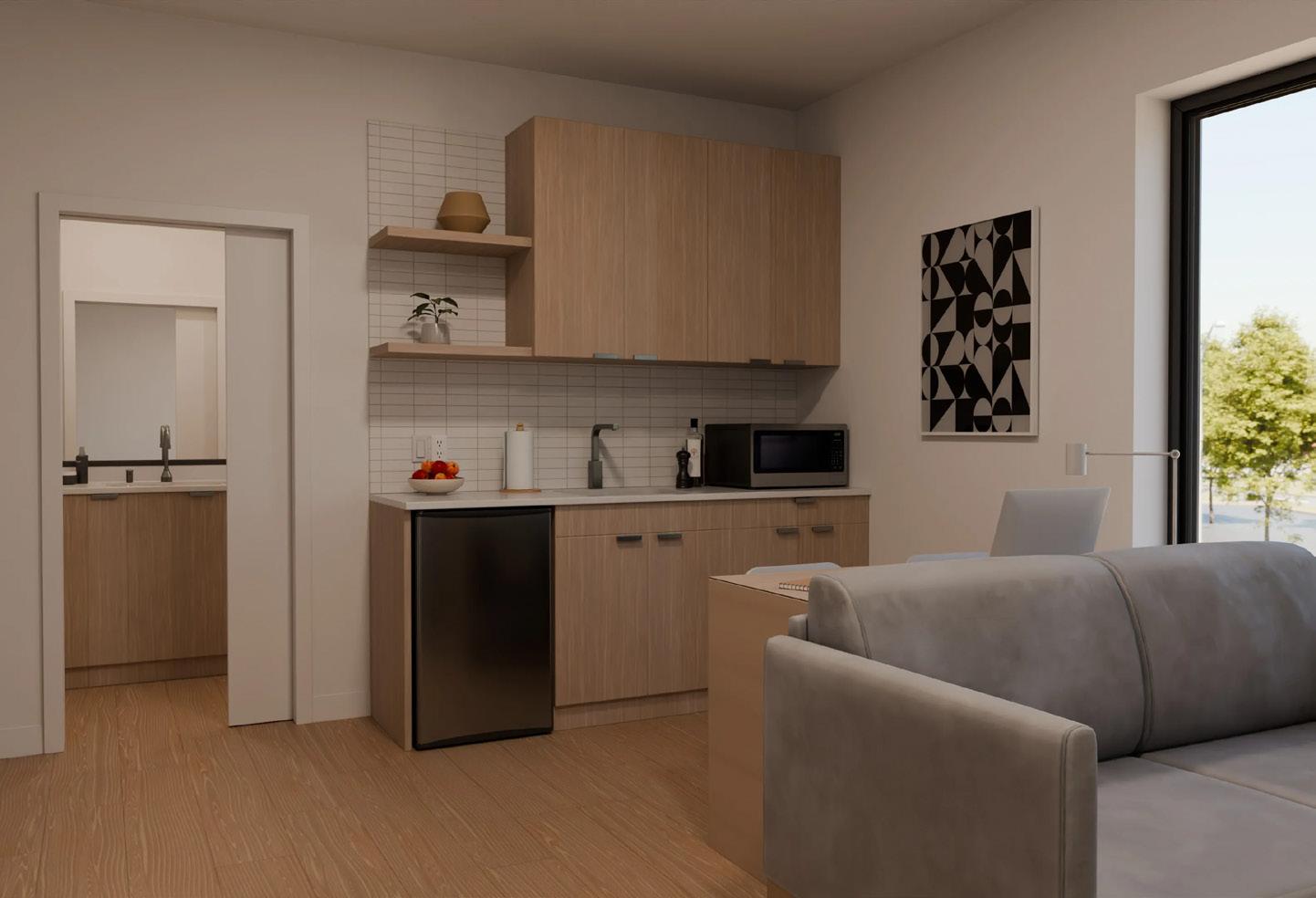
EDITOR IN CHIEF
Tarek Anthony
PRINT MANAGING EDITOR
Ryan Ehrhart
DIGITAL MANAGING EDITOR
Ysabella Sosa
NEWS EDITOR
Reilly Norgren
INVESTIGATIONS EDITOR
Ana Narayan
OPINION EDITOR
Gracie Cox
A&C EDITOR
Claire Coit
PHOTO EDITOR
Saj Sundaram
COPY CHIEF
Olivia Ellerbruch
VIDEO EDITOR
Jake Nolan
PODCAST EDITOR
Stephaine Hensley
SOCIALS EDITOR
Ysabella Sosa
VISUALS EDITOR
Noa Schwartz
DESIGN EDITOR
Eva Andrews
DESIGNERS
Adaleah Carman
PUBLISHER AND PRESIDENT
Eric Henry (X317) ehenry@dailyemerald.com
VP OPERATIONS
Kathy Carbone (X302) kcarbone@dailyemerald.com
DIRECTOR OF SALES & DIGITAL MARKETING
Shelly Rondestvedt (X303) srondestvedt@dailyemerald. com
CREATIVE & TECHNICAL
DIRECTOR
Anna Smith (X327) creative@dailyemerald.com
STUDENT SALES MANAGER
Lola Tagwerker
ACCOUNT EXECUTIVES
Elliot Byrne
Nate Ghilarducci
Emerald Media Group 1395 University St.,#302 Eugene, Or 97403 (541)-346-5511
The Big Ten Academic Alliance agreement will allow for no-cost publishing and full access to thousands of academic journals.
Angelina
Handris News Reporter
The University of Oregon entered into a publishing agreement with academic publishing company Springer Nature in May, joining other universities in the Big Ten Academic Alliance in open access for academic articles.
The two-year agreement allows UO faculty, students and staff to publish an unlimited number of articles in Springer Nature’s hybrid journals, free of article processing charges, which are fees that are paid by authors when an academic article is published. Hybrid journals combine the traditional subscription-based academic journal model with an option for open access publication.
“This agreement eliminates those individual (processing charges) and provides full reading access to over 2,200 journals across Springer, Palgrave Macmillan, Adis and academic journals on nature.com,” Esohe Yamasaki, head of communications at Springer Nature, said in an email statement.
Yamasaki said that the agreement will simplify the publication process for authors by providing faster access to published papers and easier collaboration with other authors, as well as freeing time for librarians for research and learning rather than handling licensing logistics.
“This will mean that there is less administrative work that authors need to do to get their papers out to the world, less reliance on individual authors securing funding for publication and that areas of research that receive less funding will not experience difficulties publishing papers,” Yamasaki said.
According to UO Licensing and Collection Analysis Librarian Dave Fowler, when UO joined the BTAA earlier this year, it began to participate in agreements with journal publishers. Earlier this year, UO switched its existing subscriptions with Springer Nature and Wiley, another academic publishing company, with direct subscriptions from the companies to the BTAA.
“It’s been an iterative process as we have gone along the last year figuring out which agreements we can participate in,” Fowler said.
The agreement with Wiley, another academic publishing company, permits 40 cost-free articles per school, but the Springer Nature agreement allows for an unlimited number of articles to be published free of charge, according to Fowler.
“In theory, we could publish an article every day for the rest of the year, and still not accrue any article processing charges,” Fowler said.
Authors have to meet a number of criteria in order to publish, including being a “corresponding author,” or that they are designat-
ed to work with that publisher, according to Fowler. The authors also must be affiliated with UO.
“It has to go through the usual peer review process and everything too, but once those things are achieved, they can publish in these journals at no cost to themselves,” Fowler said.
Kristin Buxton, head of science liaisons at UO Libraries, said the agreement would give undergraduate students easier access to journal articles. Currently, students can request materials from other universities via the UO Libraries InterLibrary Loan service. The process can take up to 24 hours for downloads of chapters.
“One of the biggest things that undergraduates will see is that there’s more journal articles available that they can get to directly without having to use interlibrary loan to get them, so it’s a smooth process,” Buxton said.
Buxton said that the open publishing agreement will also benefit graduate students, who can now publish an unlimited amount of work without processing charges.
Fowler said the agreement was one of a number of benefits of joining the BTAA. Over the next year there may be further access to new databases and additional open access agreements, according to Fowler.
















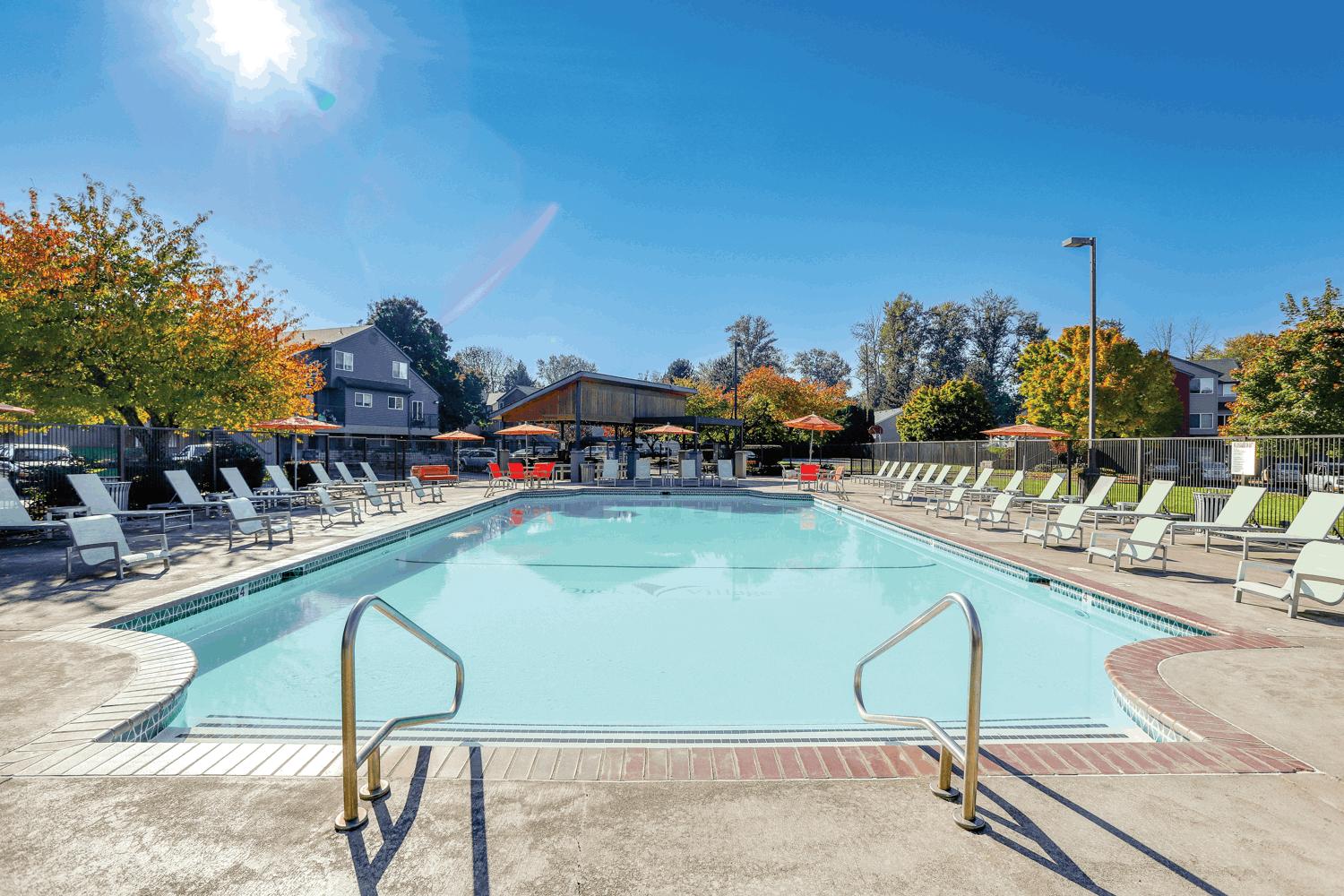





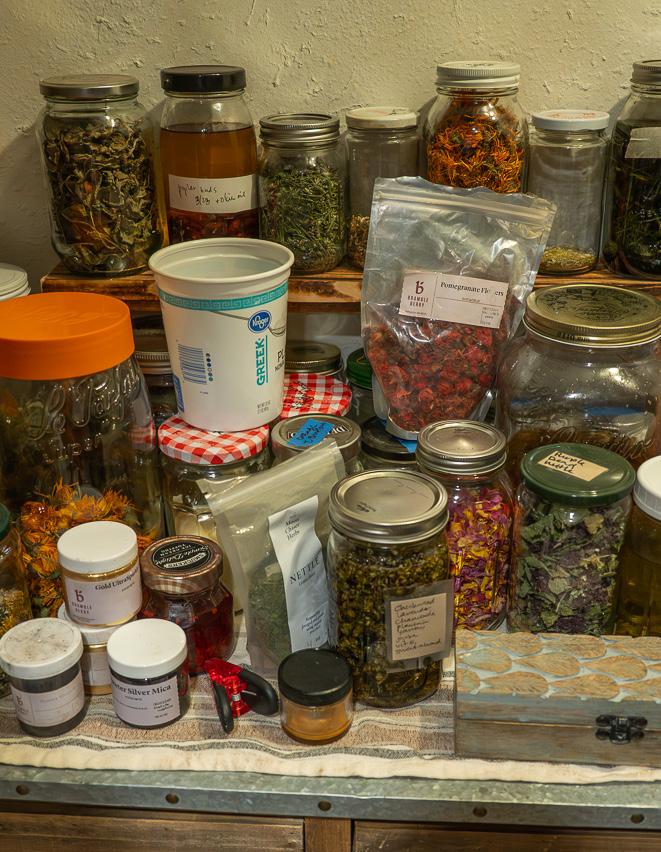
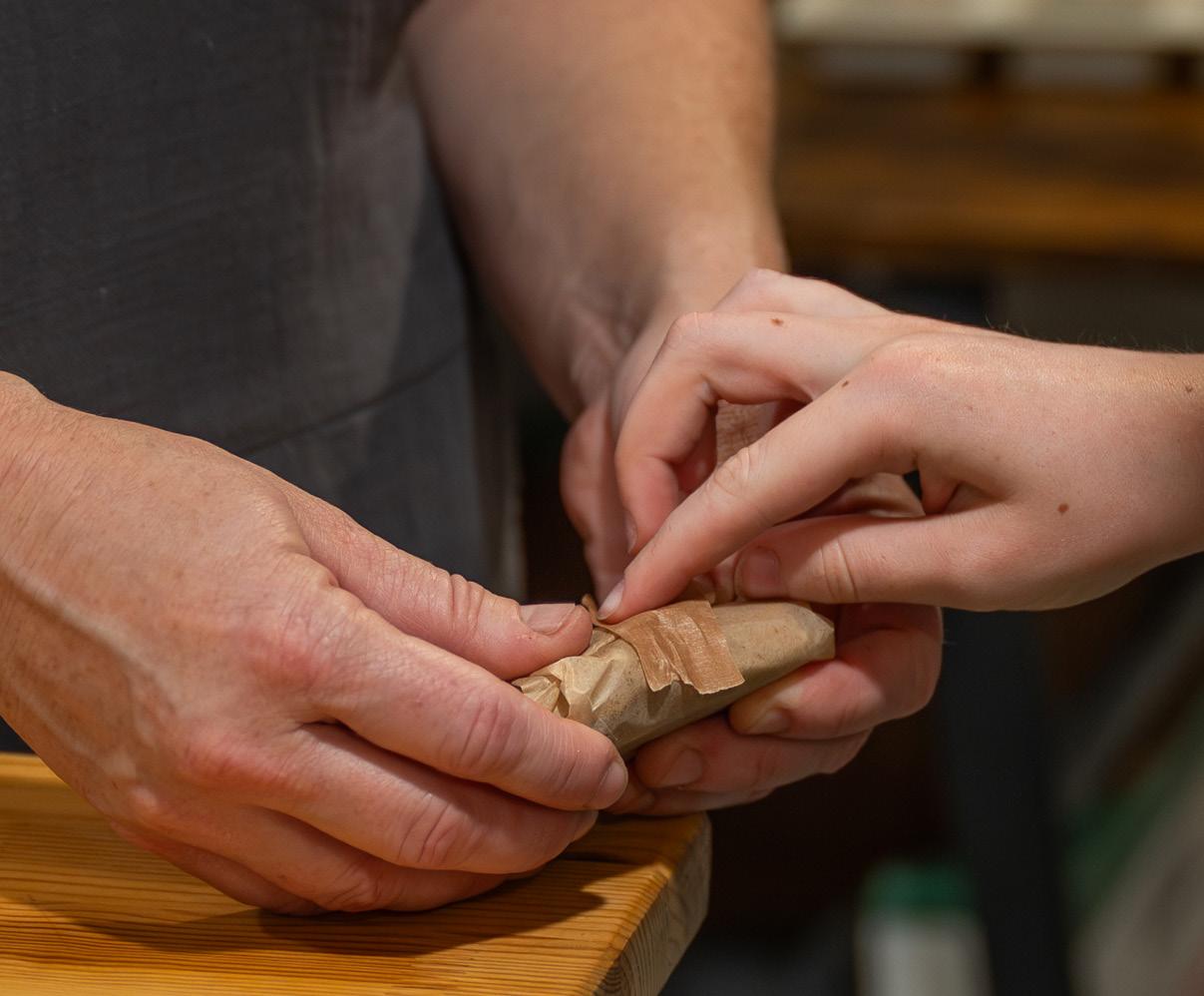






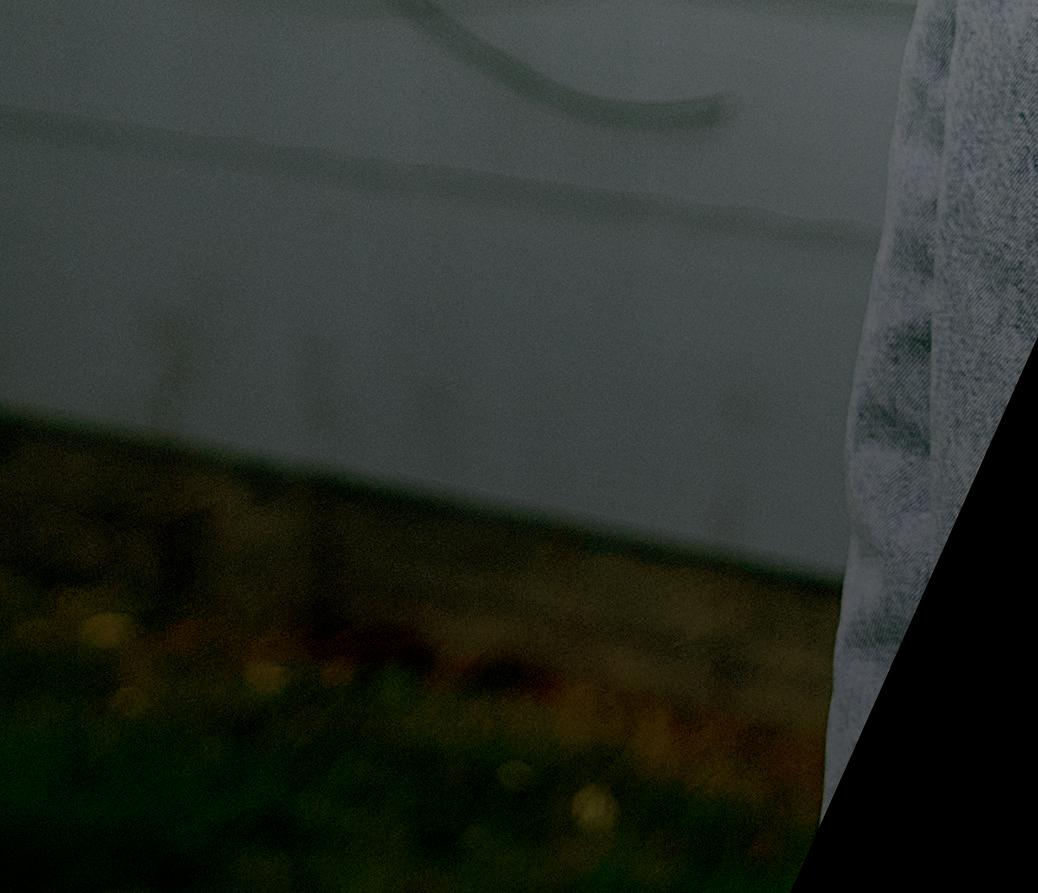


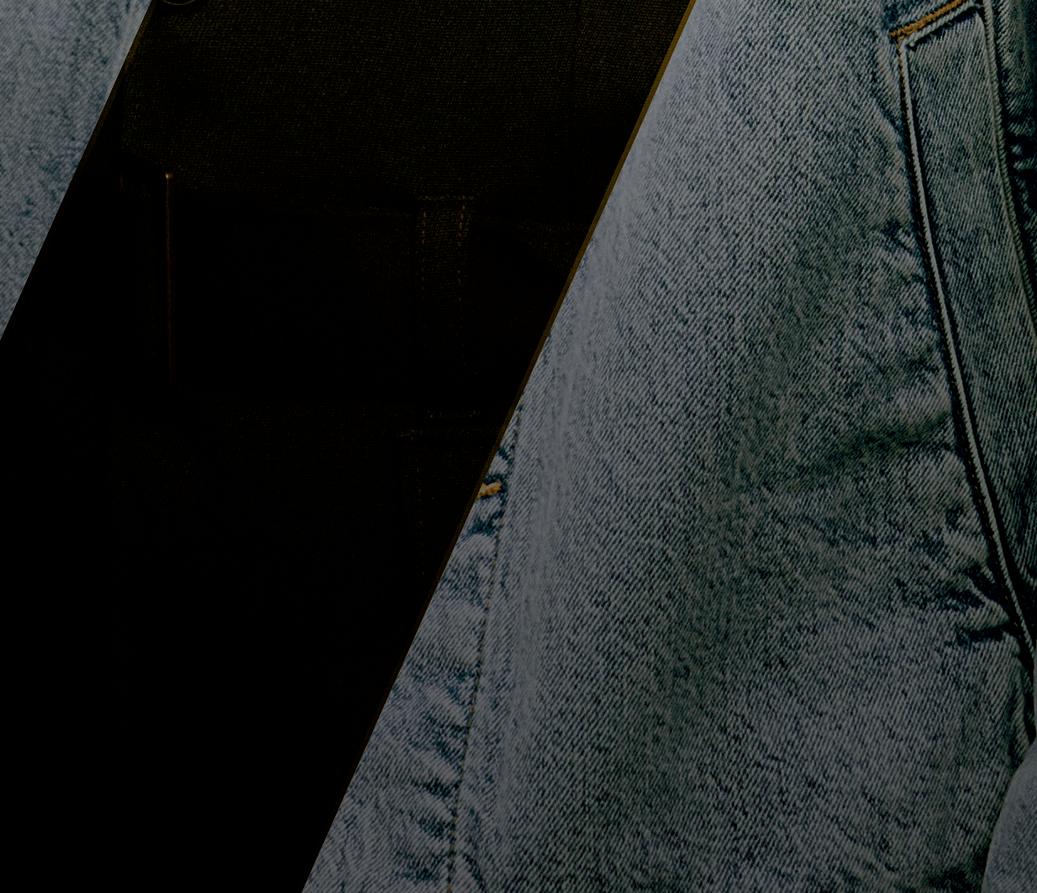






By Elle Kubiaczyk News Reporter
When students find themselves on campus late at night or otherwise feel unsafe, services like the University of Oregon Police Department’s Safety Escorts and Duck Rides offer a way to get home.
UOPD Safety Escorts are a service in which students can contact the campus police to escort them safely across campus at any time. Duck Rides is a free shuttle service that offers rides to students within the campus or downtown area from 6 p.m. to midnight. These two services both provide opportunities for students to get safe transportation around campus if they feel they need it.
The process of requesting a safety escort is straightforward: Students call the police dispatch, confirm their identity as a student and provide their location and destination. The police department has three layers of staff involved in the program, including campus security officers, police officers and student assistants.
The availability is “pretty much 24/7 or there is nothing more than a five-minute wait,” according to Chief of Police Jason Wade. The boundary within the safety escorts’ operation is flexible and not strictly confined to on-campus locations.
Wade said they are focused on getting students home safely rather than looking for things like underage drinking.
“We’re going to look to their safety over a minor violation of the law. We’re not worried about getting someone in trouble,” Wade said. He explained that there are specific accommodations safety escorts use to make students more comfortable.
“You can sit in the front seat so you’re not in the prisoner compartment,” Wade said. Additionally, students can request not to be dropped off directly in front of their destination. For those who might want to bypass riding in a police car altogether, officers can walk them home instead. However, this option is subject to staffing levels and the distance being walked.
“We try not to get too far from our vehicle. If we’re in a car, we can get you somewhere safe quicker.”
UOPD has an array of safety features installed to safeguard the well-being of users, including interior cameras, which, according to Wade, “focus on the driver’s seat and the prisoner compartment behind.” Additionally, there is GPS tracking on all vehicles.
Safety escorts are required to call out to dispatch and give them a start time, according to Wade. Any excess in time would signal immediate intervention. UOPD is present at frequently circulated locations on campus, including resi-
Late-night services around UO campus offer students safe and secure ways to get across campus or to their homes.
dence halls, the Erb Memorial Union, the Student Recreation Center and Knight Library.
“If I give 100 rides out to the people on this campus in a month and it prevents one person from getting hurt, then to me, it is completely worth it,” Wade said. “There is no doubt in my mind that this is a value. You should enjoy the campus. You should enjoy life. And if we can make that look better, you know, I would love to do that more soon.”
Duck Rides operates from 6 p.m. to 12 a.m., every day, only when classes are in session. According to Dave Reesor, director of transportation services, “Duck Rides is a free nighttime shuttle service for students and employees, and the purpose is to provide a safe alternative to walking alone. It’s provided at no cost at the curb.”
Duck Rides covers an immense boundary from on-campus locations to the majority of Eugene.
A key feature of Duck Rides is the mobile app, allowing students to enter their pickup spot, drop-off spot and schedule a ride in advance. Before the implementation of the app, riders could only request a shuttle over the phone.
The app increased passenger rides by 150%, according to Reesor.
While the service closes at midnight, Duck Rides’ collaboration with ASUO introduced Uber Night and Healthcare Rides. As a student, you get up to four rides per month that
have a $7 discount per ride, every day between 12 a.m. and 7:30 a.m. Students will receive these discounts via their UO email.
The availability of Duck Rides varies depending on the night of the week, with Thursday-Saturday between 8:00 p.m. to 11 p.m. being the busiest. However, Duck Rides can operate efficiently due to the quantity and size of the vans, according to Reesor.
“We usually aim for about six to eight vans to be on the road each night. Most of the vans we have carry about 12 passengers.” Similar to the Safety Escort Program, the vans are equipped with interior cameras, but “the student drivers are also required in our program to have a student navigator who’s assigned to them. So there are always two people in the van at the time,” Reesor said.
Both safety escorts and Duck Rides offer students safe, accessible alternatives to walking alone at night.
(Uriah Barzola/Emerald)
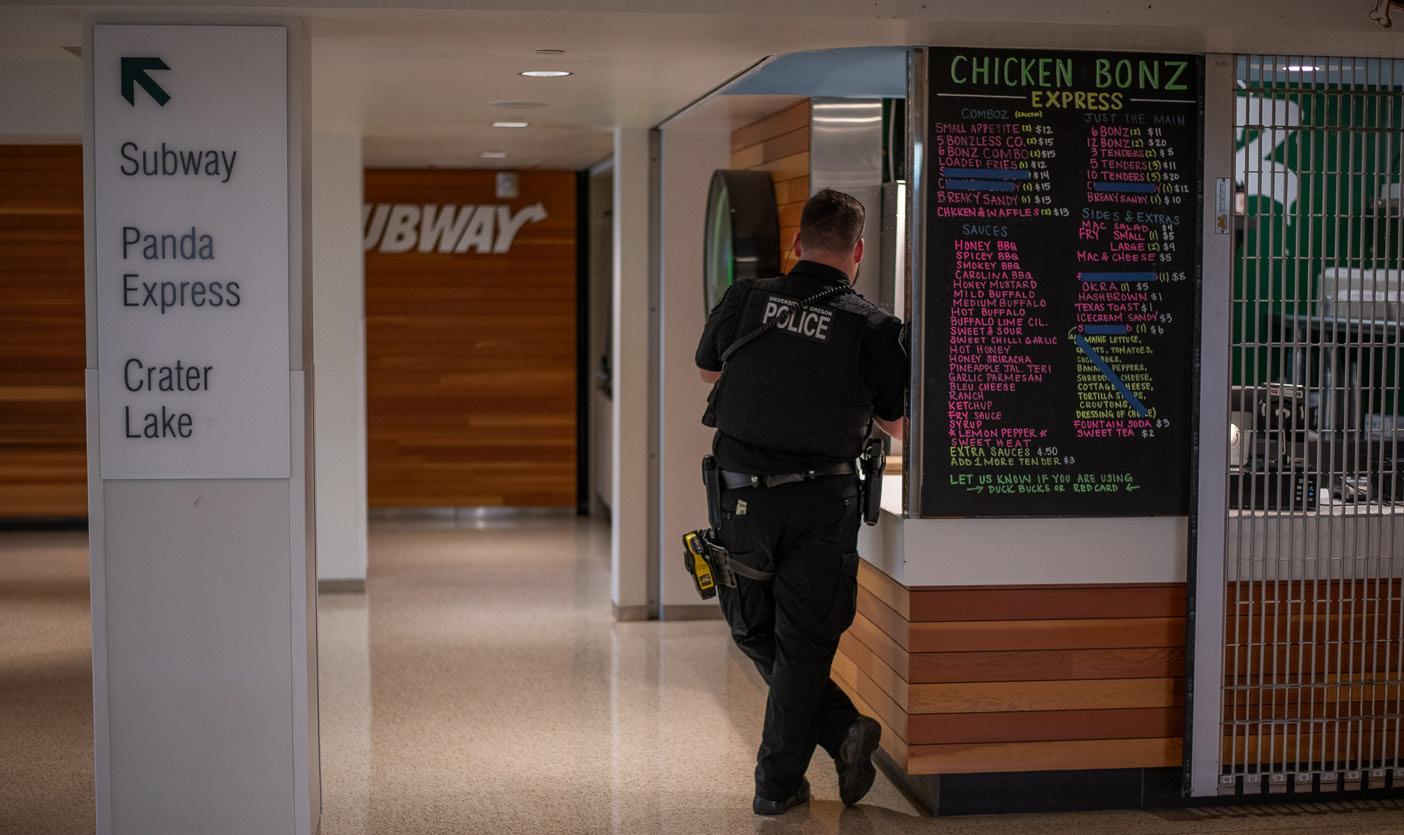

Continued from page 1
Since several bikes went unclaimed last summer and were donated back to the community, the program was scaled back both to gauge interest and because of space limitations on short notice, according to Howald.
“It wasn’t officially decided to restart the program until early April,” he said. “After that we had to figure out the exact size and shape and figure out where to store bikes. Those decisions weren’t finalized until May.”
Recent UO graduate Jack Skidmore had his bike stolen four times while at UO. Skidmore never reported these thefts because he figured it was a “lost cause,” he said. “I’ve never met anyone who has gotten their bike stolen in Eugene and got it back from doing a police report.”
Since his last bike was stolen, he hasn’t bought another. Instead, he uses PeaceHealth rental bikes, which allow students to rent and return bikes at hubs across Eugene and Springfield.
“I don’t think there’s a lot of attention to bike theft from local authorities,” Skidmore said. “They could do more to
ensure it doesn’t happen, especially on a campus where bikes are part of students’ livelihoods.”
One of the main anti-theft initiatives UOPD is currently focusing on is “bait bike” — a sting operation designed to catch bike thieves — which they experimented with in 2020 but ultimately didn’t end up implementing any bikes due to the COVID-19 pandemic and staffing issues. While they are continuing to work on technology, according to Chief Wade, UOPD is still working through contracts to get the technology set up for tracking bait bikes.
“We’ll have a bicycle of the appropriate style, type and attractiveness to thieves positioned somewhere on our campus mixed in with other bicycles, secured like any other, but with transmitters and tracking technology,” he said.
If stolen, UOPD will be able to track the bicycle’s location in real time, enabling officers to catch suspects in the act, recover the bike and see where they take it to potentially locate additional stolen property.
When fall term resumes, UOPD plans to have the program “up and running” and set up the bikes near hotspots on campus based upon crime data from previous years.
UOPD is also currently looking into enhanced camera technology in collaboration with UO Housing to identify various cages on campus and high populated areas for bikes.
With around 10 identified “hotspots on campus,” UOPD plans to activate extra detection software in the surrounding cameras, near bike cages for instance, which can detect the difference in motions between unlocking a lock and cutting a lock.
“What this software does is it highlights certain hours of the day when someone goes into the cages, and we’re particularly looking at those after hours thefts,” Chief Wade said. “Because we have so many cameras on campus, we can’t watch all of them all the time, but it’ll bring attention to one on the big screen.”
Due to limited funding, UOPD is still working to implement the software to ensure they “get the best results for the best amount of money,” Chief Wade said.
On March 5, on the corner of East 15th Avenue and Agate Street in front of Hayward Field, UOPD launched “Cut the Cable,” a bike lock upgrade program that partnered with ABUS locks, UO Transportation Services and Project 529 — a bike registration service — to provide students on campus with brand new U-style Kryptonite locks.
For two hours, students on campus could bike by and UOPD officers would show them just how quick and easy it was to cut their cable locks with bolt cutters, Chief Wade said.
“Once we cut their lock, they had to sign up for the UO 529 project or show that their bike was registered, and then we showed them how it works,” he said. “After that, we would give them the bike theft prevention lock.”
UOPD hopes to host another Cut the Cable program during fall term. The current goal, according to Chief Wade, is to work together, specifically with UO Transportation Services to reinforce and protect bike cages.
“To me, the best answer is to protect the physical barriers the most that we can,” he said. “We’re advocating to reduce the small individual bike racks out there, or secure interior bike cages for outside bike cages, so we can centralize them and protect them better.”
Despite UOPD’s long standing theft prevention efforts such as “No Bike Left Behind,” and Project 529, the rise in bike thefts on campus have not declined in 2024, and continue to increase.
Chief Wade advises students to get a bike for the right reasons. “Make sure that you need a bike, and it’s useful,” he said. “Put a little thought into it, think about where you’re parking it, where you’re locking it up, how long it’s there and how nice it is.”
He said the best theft prevention is to use interior spaces or utilize PeaceHealth rental bikes.
“Blue bikes are great because they’re not yours to get stolen, and they’re everywhere,” he said.
Students can also rent bikes through the UO’s Bike Program, which operates under the larger Outdoor Program located in the Erb Memorial Union. The program also offers free do-it-yourself classes, bike maintenance, rides and campus biking information.
Each rental bike is registered under Project 529 and includes a Kryptonite U-lock and 4-foot cable free of charge, Bike Program manager Logan Devack said.
Devack said students frequently seek advice about preventing bike theft, “Unfortunately those questions usually come after they’ve already had their whole bike stolen,” he said.
“I am still pursuing opportunities for us to have a closer relationship to help our students reclaim any stolen bikes or equipment,” Devack said. “The first step is always getting people educated.”
He said many new and prospective students often ask if they should bring their “$4500 full-suspension mountain bike” to campus, given Oregon’s trail access, but due to most bike and parking storage in UO dorms being “sub-par” he often discourages students against it.
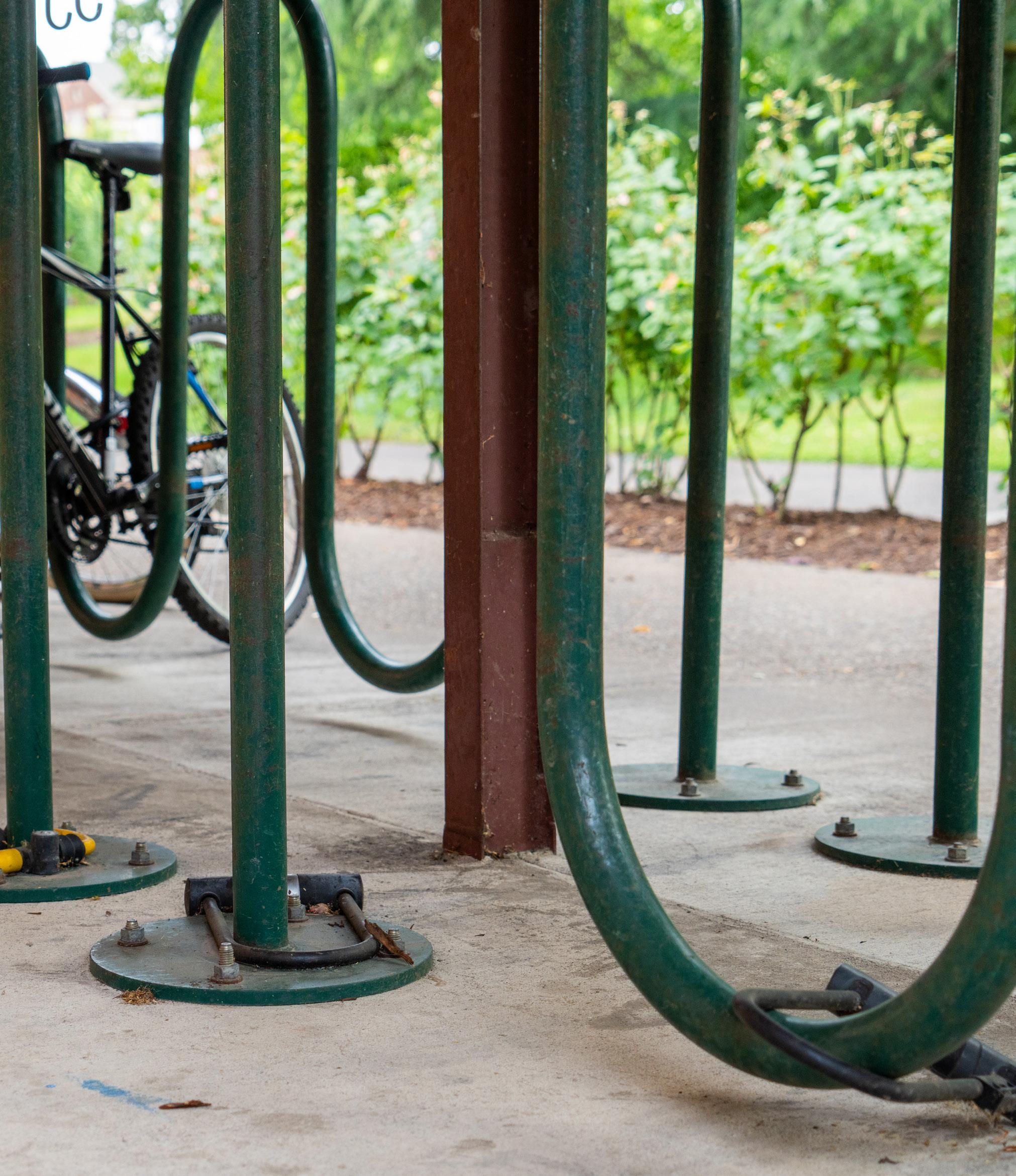
Why is it that one must hunt for an ordinary lease while ads to fill vacancies in studentcentered high rises never end?
By David Morgan Opinion Columnist
I am constantly inundated with ads to move to one of the flashy student high-rises. For someone who had to scour for a lease in an ordinary apartment, the surplus feels surreal. These Purpose-Built Student Accommodations somehow orbit outside Eugene’s strained rental market.
While our city limps at a vacancy rate of 3.45%, well below the “healthy” 5%, PBSAs have swelled to 8.25%.
This is the direct legacy of a decades-long construction blitz fueled by real estate investment trusts and private equity chasing predictable revenue streams. While the student population only represents 10% of Eugene’s housing market area, PBSAs accounted for nearly 33% of all new rental construction since 2010.
Why did capital investment flow so disproportionately into student high-rises?
A lower risk profile plays a role. Because PBSAs lease by the bed, revenue largely stays intact even if one roommate bails and a parent cosigner stands behind nearly every contract. College enrollment also usually holds firm when recessions hit; rent checks keep coming even as conventional landlords brace for missed payments.
Higher profit margins sweeten the lure. PBSAs

Aishiki Nag is a sophomore, double majoring in Political Science and Global Studies. She loves all things local government and state policy.
face brisker turnover compared to their conventional counterparts, letting landlords raise rent prices quicker and with minimal resistance.
The result is a city that now operates dual rental markets: the starved traditional market and the oversupplied PBSA market. Paradoxically, not enough, yet too much.
The imbalance is poised to widen. While UO has posted record-high enrollment for several years, 2023 appears to mark the trend’s plateau, with lower enrollment continuing from 2024 onward. National demographic headwinds suggest this is only the beginning.
Moreover, it is just as important to note who these future Ducks are: the proportion of in-state students is climbing while out-of-state enrollment is waning.
The demographic PBSAs were engineered to attract, therefore, are shrinking, while the construction of PBSAs, seen by new proposals, continues onward. Today’s 8.25% vacancy rate will surely wade into double digits soon.
This is a major problem. These PBSAs take up space, demand time from permit holders and occupy much-needed trade workers while no longer fixing a gap in Eugene’s housing market.
They’re also incredibly hard to convert to regular housing due to their wonky floor plan with a bathroom for every occupant.
A resident of a recently constructed PBSA, third year Alyssa Waterson explained how she faced flooding in this brand-new building and had to “keep everything off the ground in fear of it being ruined.
Students are feeling the pain of this dual housing crisis: with conventional listings quickly snapped up, many have no choice but to sign the inflated
but readily available PBSA leases, draining loan budgets and paychecks alike while the promised “luxury” leaks, molds or floods around them.
Non-college residents endure the same squeeze, watching rents climb while vacancies vanish.
I do not advocate for government intervention lightly, but this is an instance where it may be needed.
The City of Eugene has the most direct lever of power. No building can rise without the city’s approval, so being more intentional with its permitting process can aid in a much-needed private sector correction.
After all, when looking at building plans, it’s not that hard to tell who the space is meant to serve.


David is an opinion columnist for The Daily Emerald and a senior studying Data Science, Economics and Philosophy. In his writing, he enjoys finding the abstract relationships between systems and the decisions we make everyday, weaving them into a tangible story readers can easily digest.
The state of Oregon needs to work swiftly to address the impact of commercial and personal use of pesticides, which is leading to a devastating decline in the native bee population.
Bloom currently serves as the coordinator for the Save the Bees campaign of the Oregon State Public Interest Research Group, which aims to target harmful or even lethal pesticides known as neonicotinoids. This project initially introduced HB 2679, a bill intended to ban the sale of neonics in the context of consumer purchases, but it didn’t pass the work session.
Bloom explains, “one in four bees are dying, and we know that it’s because of habitat loss, climate change and pesticide use – the first two reasons we can’t combat super quickly, but we can put a damper on pesticides, especially in retail use.”
This pesticide acts as a neurotoxin for insects and has a “systemic” application, meaning that farmers and consumers can directly apply it to the ground, helping plants grow. It comes with a coating to repel insects, although this has been responsible for the non-targeted death of beneficial insects, such as pollinators. A 2015 study by the U.S. Geological Survey showed that over half of all streams sampled contained traces of neonicotinoids, demonstrating their widespread use and toxicity.
Bloom continued to explain the importance of the bill, “25% of the bee population is dying due to this, but you
can buy (these pesticides) at a garden store for your home garden.”
Although the bill did not pass through the 2025 session, Bloom persisted with the campaign to raise awareness about the importance of legislative and grassroots actions in protecting the pollinator community. She organized Oregon Native Bee Day with the partnership of Beyond Toxics, Environment Oregon, McKenzie River Lavender farm, Lane County Beekeepers Association and the University of Oregon Bee Friendly Committee.
“They make up all of our food and all of our produce, coffee, chocolate, flowers — the things people love most,” Bloom explained. “We realized people aren’t even talking about the loss of bees and what they do for us.”
Oregon Gov. Tina Kotek notably marked May 15 to focus on bees and acknowledge the devastating loss of the bee population in Oregon, but there was no further action planned regarding the crisis facing our state. Bloom’s community organization was important in starting the conversation about the harms of neonicotinoids, in the heart of Bee City USA, or as we know it, Eugene.
The city of Eugene had notably proclaimed itself as Bee City USA and was also the first city to ban the sale of neonicotinoids for commercial use. The challenge now is to
bring this sentiment to the state and pass legislation. Bloom ends on the reality of inaction for our pollinators: “The world is dulling.”
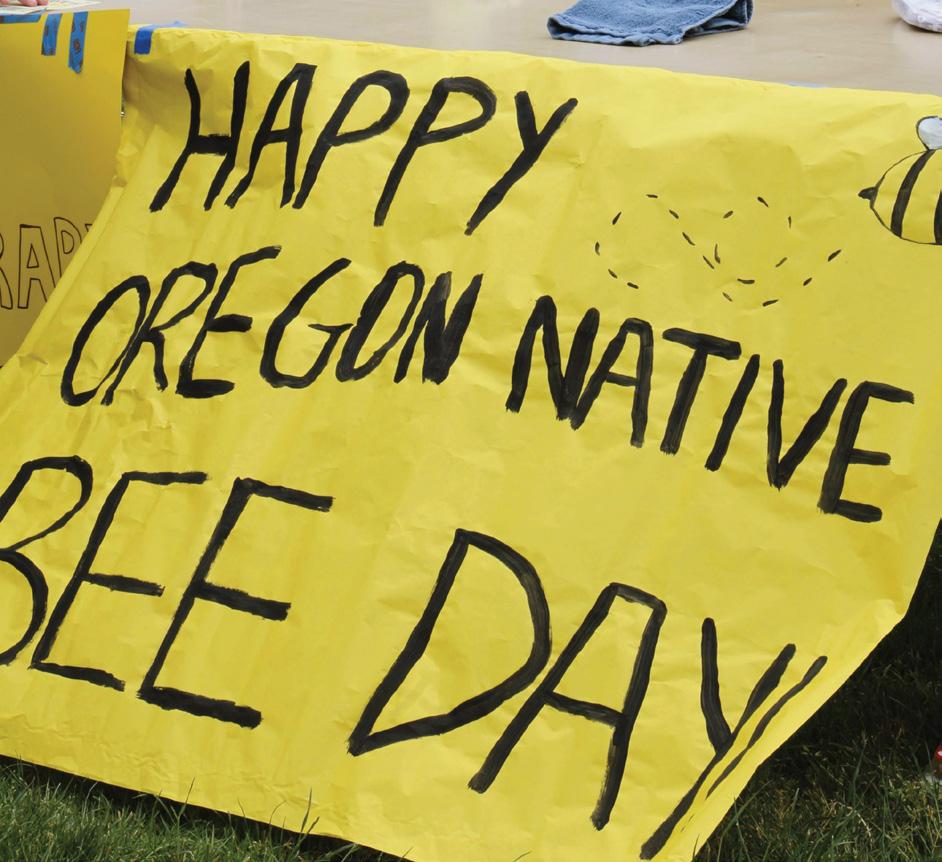




“The Emperor of Gladness” by Ocean Vuong
Last winter, I read Vuong’s “On Earth We’re Briefly Gorgeous.” The work was so thought-provoking and eloquent; I knew it wouldn’t be the last of Vuong’s works I read. So, when I learned aboutof the release of “The Emperor of Gladness” via an interview with Oprah Winfrey, I was excited.
An Oprah’s Book Club Pick, “The Emperor of Gladness” is about a small town teenager named Hai who forms an unexpected, deep relationship with an elderly woman experiencing dementia after she convinces him not to take his own life.

With a busy summer ahead and a too-long “to be read” list, four books stood out as must-reads.
“The book is a wonderful opportunity to recalibrate value systems, to create a different hierarchy of values,” Vuong said to Winfrey.
Vuong discussed the importance of landscape and its history in this novel, arguing the inextricable tie between the two. Despite the novel being marketed as literary fiction, Vuong considers it historical fiction, and I believe I will enjoy it, given the promise of his past work and the unexpected connections between the tangible and intangible.
& Lovers” by Lily King
To pursue a creative career, or to live securely? That is the question this novel asks, as its synopsis makes these two things mutually exclusive.
In “Writers & Lovers,” it’s the summer of 1997, and 31-year-old Casey Peabody struggles to support herself as a waitress and aspiring author. Balancing the demands of art and life, Casey refuses to relinquish her creative ambitions as her friends have done. There is also a love triangle.
A novel set in summer with romance and a relatable protagonist? Count me in, please.
“Small Boat” by Vincent Delecroix
Shortlisted for the International Booker Prize this year, “Small Boat” is a fictional work based on a true story about the drowning of 27 migrants in the English Channel in November 2021. Migrants had phoned French authorities numerous times for help, but they had refused to send a rescue team, telling them they had to call the British authorities,
and resulting in the deaths of all but two on board. What struck me about this story is that it’s narrated by the telephone operator who works for the French authorities, the one and who refuses to send the rescue team. Positioning readers to see through the lens of the operator may make it easier or harder to demonize them; I don’t yet know, but I do know that this choice of perspective will provide a story incredibly different from the one that would’ve been told had Delecroix chosen to write from the potentially more obvious perspective of one of the migrants.
Of all the considerations the shortlist entertained, those of “Small Boat” haunted me the most.
There’s nothing like a book recommendation from a mentor whose taste in books you trust more than your own. When I told a professor of my aspiration to work in the publishing industry, she suggested I read “My Salinger Year.” Shortly after, I read the synopsis about 23-year-old Rakoff in late 1990s New York, finding her authorial voice as an assistant, responding to author J. D. Salinger’s fan mail.
A change of pace from my fiction-heavy list and an opportunity to familiarize myself with the history of literary New York, “My Salinger Year” may be the recommendation I didn’t know I needed.
In a summer that never seems to have enough time to read all the books one desires, these four books will be read by me. What’s at the top of your summer will-read list?
Picnic season is upon us. Celebrate it with these vibrant recipes.
By Fern Peva Arts & Culture Writer
This summer, retire your played-out picnic recipes and give these flavorful and unique recipes a try. All three of these dishes focus on refreshing flavors to ensure your picnic stays crisp and light on a hot day.
A summer tomato is one of life’s simple pleasures. When paired with nutty, toasted sesame oil and the umami flavor of the Furikaki, this sandwich will bring your picnic to the next level.
Ingredients:
• Sourdough bread
• Mayonnaise
• Sriracha or chili paste/oil
• Sesame oil
• Furikake (Japanese rice seasoning)
• Heirloom tomatoes
• Olive oil
• Salt and pepper
• Thinly sliced green onions
*Measurements depend on your personal preferences
1. Start by slicing your sourdough into two thick slices, between 1/2” and 1” is ideal. Drizzle your bread with olive oil and toast it to your liking.
2. While your bread is toasting, in a small bowl, mix mayonnaise, sriracha and sesame oil. *Be careful! A little bit of sesame oil goes a long way.
3. Next, slice your tomatoes into thick 1” pieces and season with salt, pepper and a drizzle of olive oil.
4. Once your bread is finished toasting, spread each side of the bread with the spicy mayo you made earlier.
5. Finally, add your tomatoes to the bread. Top with furikake seasoning and green onions. Put your sandwich together and voila!
Inspired by the seasonal smoked salmon salad at Izakaya Meiji, this salad is my take on this classic summer dish. With the newly trending tinned fish as a star ingredient, this dish is a great picnic pick.
Ingredients:
• 1 large peeled grapefruit
• Your favorite spring mix of greens
• Microgreens
• 1 tin smoked trout, deboned
• 1 avocado
• 1/3 cup toasted pine nuts
• 1/2 cup grapefruit juice
• 2 teaspoons sesame oil
• 1 tablespoon red wine vinegar
• 3 tablespoons honey
• 1 teaspoon salt
• Onion powder (to your liking)
• Garlic powder (to your liking)
• 1 cup olive oil
1. Start by adding your salad mix and microgreens into a bowl and preheating the boiler on your oven.
2. Next, peel your grapefruit and split your avocado. Dice them both into bite-sized pieces. Add them both to your bowl with the greens.
3. Spread the pine nuts out on a baking sheet and put them under the broiler for a minute or two. Be careful, they will toast very quickly.
4. Drain your tinned trout and crumble the filets into smaller flaky pieces. Add them to the bowl.
5. Next, combine the grapefruit juice, sesame oil, vinegar, honey and seasonings into a blender and blend. Slowly drizzle the olive oil into the dressing as you blend until it is well combined.
6. Top your salad with the toasted pine nuts, toss with the sesame grapefruit dressing and enjoy!
This quick hummus recipe will elevate any picnic spread. It can be paired with veggies, pita chips or whatever you desire.
• 1 can of chickpeas drained and rinsed (save some of the drained liquid for later)
• 1/4 cup of tahini
• 2 tablespoons olive oil
• 2 garlic cloves
• Juice of 1 lemon
• Zest of 1 lemon
• 1/4 cup of basil
• Ice cubes
• Salt to taste
1. In a blender or food processor, add chickpeas, tahini, lemon juice, lemon zest, garlic and salt. Blend until it is chunky smooth.
2. Next, add the basil, the liquid from your can of chickpeas and olive oil until it is incorporated.
3. While the food processor is still running, add ice cubes until it reaches your desired consistency. *You can use cold water instead, but ice works best
4. Carefully pour your hummus into a bowl or Tupperware container.
5. Grab some pita chips or some fresh veggies to dip. I like cucumbers and carrots best. Drizzle with olive oil and more lemon juice before serving!
These three recipes incorporate light and refreshing flavors that will have you looking forward to lunchtime all summer long. Give those basic peanut butter and jelly sandwiches a rest this season and try one of these flavorful and unique recipes instead.
An indoor national title boosted the Ducks to their first win in the category in six years.
By Owen Murray Associate Sports Editor
The University of Oregon’s women’s track and field team was selected on June 17 as the best program of 2024-25 by the U.S. Track and Field and Cross Country Coaches Association. The Ducks, who won the indoor NCAA national championship and won two of three Big Ten titles, were chosen based on points accumulated according to their final position in the cross-country, indoor and outdoor seasons. The award is Oregon’s first since 2019 and 11th in the women’s program history.
Oregon finished fifth overall in the cross-country season, where it won the Big Ten title and had three female athletes — Şilan Ayyildiz, Maddy Elmore and Anika Thompson — selected as All-Americans based on their top 40 times. Ayyildiz won the Big Ten race and finished 13th overall in the cross-country national final.

The indoor season was when the Ducks captured their first women’s national championship of any kind since 2017, when they swept the indoor and outdoor titles. In 2025, it wasn’t close. After winning the Big Ten indoor title, Oregon (55 points) outperformed second-place Georgia at the national meet by 16 points. First-place finishers are awarded 10 team points, with second receiving eight, third place receiving six and fourth receiving five, descending to eighth place (one point).
In Virginia Beach, the Ducks had just one individual champion — miler Wilma Nielsen, who finished in 4:32.40 with Ayyildiz in fourth place. Jaydn Mays finished second in both the 60-meter and 200-meter finals and Olympian Jaida Ross finished second in the shot put. The win was head coach Jerry Schumacher’s first of his Oregon tenure.
With the shift to the outdoor season came a change to the roster. Mays and Ross exhausted their eligibility with the indoor season, and the Ducks had to turn to a different set of faces for a charge at the championship. Klaudia Kazimierska, who missed much of the indoor season with an injury, returned to headline Oregon’s strong middle-distance group that also included Ayyildiz (the indoor and outdoor collegiate mile record-holder) and Mia Barnett. Before the Big Ten Championships, where the Ducks finished second behind USC, those three were all top-four 1500-meter runners in the conference.

Oregon didn’t have the same firepower at the NCAA Outdoor Championships, where it won just one event (Aaliyah McCormick in the 100-meter hurdles), finished fourth (Ayyildiz) and fifth (Kazimierska) in the 1500m final, and ended the meet 10th overall with a 23 point total. That finish, though, was enough to push the Ducks to the top of the women’s program standings: five points from cross-country, plus one point from the indoor season and 10 from outdoor gave them a 16-point total — six points better than second-place rivals Washington.
Next year is still up in the air for the Ducks — some athletes, like Ross and Kazimierska, turned professional following the season. Oregon is set to host the NCAA Outdoor National Championships at Hayward Field once again in June 2026 nonetheless.

What to look for as the Ducks get ready to kick off the 2025 season.
By Joe Krasnowski Sports Writer
Perfection comes to mind when one thinks of Oregon football’s 2024 season. The Ducks were perfect in the regular season, going an impeccable 12-0, but it was bittersweet after the Ducks got trounced 41-21 by Ohio State in the Rose Bowl.
That brings us here: Weeks away from an August 30 kickoff against Montana State University, the Ducks will look to build upon their regular-season success while utilizing some of that playoff experience to their advantage. However, that is much easier said than done. To get back to a pivotal CFP game, the Ducks will need to capitalize on their ranked games while receiving a significant boost from their first true class of Lanning-recruited talent. Oregon likely won’t have to be perfect in 2025, but it certainly helps.
Sept. 27 @ Penn State
A rematch of the 2024 conference championship game, the Ducks will get to travel to Beaver Stadium and check off another box on their new(ish) conference’s hardest places to play.
Combining the crowd, which will be fueled by the Nittany Lions’ “white out” and Penn State’s mostly-returning roster, this early-season matchup might just be the toughest one Oregon faces all year.
Nov. 8 @ Iowa
Without a doubt, the Ducks’ second-toughest road matchup, Oregon will travel to play against an Iowa team that is always tough to play against. Although not the flashiest, Iowa can be expected to run the ball and control the trenches. With the weather almost certainly to be a factor, the Ducks will have to be ready.
Nov. 22 vs USC
The Ducks’ marquee home game comes late in the season against a Trojans team that struggled to adapt to the Big Ten last season. Although USC lost some of its top talent to the transfer portal last season, the unexpected can happen in rivalry games — a caveat the Ducks will have to be ready for. Regardless, a “blackout” themed fan base that hosts a significant number of students from California will be ready to cheer on their Ducks on what will likely be national television. Overall, the biggest matchups for Oregon are the ones not yet on the schedule. Any season in the foreseeable future that doesn’t feature a conference championship and CFP game will be viewed as a disappointment. That
may sound lofty, but it’s certainly a representation of the heavyweight class the Ducks are now fighting in.
Dante Moore Quarterback
Now instilled as the sure-fire starter, the UCLA transfer will have ample opportunity to show his growth in a year sitting under Dillon Gabriel. Although not the runner that Gabriel or Bo Nix was, Moore has NFL-caliber arm talent — something that Offensive Coordinator Will Stein is sure to be excited about.
Kenyon Sadiq Tight End
Hurdling into the national stage late last season, Sadiq is expected to be a top option in Stein’s offense and has all types of NFL upside.
Bryce Boettcher Linebacker
With the fan-favorite returning for one more year, Boettcher will anchor a defense bolstered by an influx of new talent. The linebacker had 94 total tackles last season and is expected to improve upon that number in his second season as a full-time starter.
Dakorien Moore Wide Receiver
A unanimous top-10 recruit in his class, Moore has some of the best run-after-catch ability in the country and is expected to contribute right away.
Dillon Thieneman Safety
A Purdue transfer, Thieneman was one of the best defensive backs in the country last season and should improve even more by being surrounded by top talent.
Bear Alexander Defensive Tackle
Alexander was able to fill the NFL-caliber gap that Jordan Burch and Derrick Harmon left last year.


